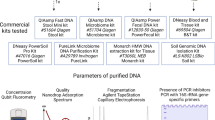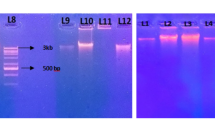Abstract
Metagenomic DNA from sediments of selective estuaries of Goa, India was extracted using a simple, fast, efficient and environment friendly method. The recovery of pure metagenomic DNA from our method was significantly high as compared to other well-known methods since the concentration of recovered metagenomic DNA ranged from 1185.1 to 4579.7 µg/g of sediment. The purity of metagenomic DNA was also considerably high as the ratio of absorbance at 260 and 280 nm ranged from 1.88 to 1.94. Therefore, the recovered metagenomic DNA was directly used to perform various molecular biology experiments viz. restriction digestion, PCR amplification, cloning and metagenomic library construction. This clearly proved that our protocol for metagenomic DNA extraction using silica gel efficiently removed the contaminants and prevented shearing of the metagenomic DNA. Thus, this modified method can be used to recover pure metagenomic DNA from various estuarine sediments in a rapid, efficient and eco-friendly manner.



Similar content being viewed by others
References
Alm EW, Zheng D, Raskin L (2000) The presence of humic substances and DNA in RNA extracts affects hybridization results. Appl Environ Microbiol 66:4547–4554
Amorim JH, Macena TN, Lacerda GVJ, Rezende RP, Dias JC, Brendel M, Cascardo JC (2008) An improved extraction protocol for metagenomic DNA from a soil of the Brazilian Atlantic rainforest. Genet Mol Res 7:1226–1232
Bag S, Saha B, Mehta O, Anbumani D, Kumar N, Dayal M et al (2016) An improved method for high quality metagenomics DNA extraction from human and environmental samples. Sci Rep 6:26775
Bertrand H, Poly F, Van VT, Lombard N, Nalin R, Vogel TM, Simonet P (2005) High molecular weight DNA recovery from soils prerequisite for biotechnological metagenomic library construction. J Microbiol Methods 62:1–11
Burgmann H, Pesaro M, Widmer F, Zeyer J (2001) A strategy for optimizing quality and quantity of DNA extracted from soil. J Microbiol Methods 45:7–20
Clegg CD, Ritz K, Griffith BS (1997) Direct isolation of microbial community DNA from humified upland soils. Appl Microbiol 25:30–33
Daniel R (2005) The metagenomics of soil. Nat Rev Microbiol 3:470–478
Devi SG, Fathima AA, Radha S, Arunraj R, Curtis WR, Ramya M (2015) A rapid and economical method for efficient DNA extraction from diverse soils suitable for metagenomic applications. PLoS ONE 10:7
Fredriksson NJ, Hermansson M, Wilén B-M (2013) The choice of PCR primers has great impact on assessments of bacterial community diversity and dynamics in a wastewater treatment plant. PLoS ONE 8:e76431
Hanahan D (1983) Studies on the transformation of Escherichia coli with plasmids. J Mol Biol 166:557–580
Handelsman J, Rondon MR, Brady SF, Clardy J, Goodman RM (1998) Molecular biological access to the chemistry of unknown soil microbes: a new frontier for natural products. Chem Biol 5:245–249
Holben WE (1994) Isolation and purification of bacterial DNA from soil. In: Weaver RW, Mickelson SH (eds) Methods of soil analysis, part 2. microbiological and biochemical properties, SSSA book series no. 5. Soil Science Society of America, Madison, pp 727–751
Hugenholtz P, Pace NR (1996) Identifying microbial diversity in the natural environment: a molecular phylogenetic approach. Trends Biotechnol 14:190–197
Kresk M, Wellington EMH (1999) Comparison of different methods for the isolation and purification of total community DNA from soil. J Microbiol Methods 39:1–16
Lakay FM, Botha A, Prior BA (2006) Comparative analysis of environmental DNA extraction and purification methods from different humic acid-rich soils. J Appl Microbiol 100:1365–1373
Lorenz P, Schleper C (2002) Metagenome-a challenging source of enzyme discovery. J Mol Catal B Enzyme 9:13–19
Luna MG, Anno DV, Danovaro R (2006) DNA extraction procedure: a critical issue for bacterial diversity assessment in marine sediments. Environ Microbiol 8:308–320
Martin-Laurent F, Philippot L, Hallet S, Chaussod R, Germon JC, Soulas G, Catroux G (2001) DNA extraction from soils: old bias for new microbial diversity analysis methods. Appl Environ Microbiol 67:2354–2359
Miller DN, Bryant JE, Madsen EL, Ghiorse WC (1999) Evaluation and optimization of DNA extraction and purification procedure for soil and sediments sample. Appl Environ Microbiol 65:4715–4724
More MI, Herrick JB, Silva MC, Ghiorse WC, Madsen EL (1994) Quantitative cell lysis of indigenous microorganisms and rapid extraction of DNA from sediments. Appl Environ Microbiol 60:1572–1580
Nair HP, Vincent H, Bhat SG (2014) Evaluation of five in situ lysis protocols for PCR amenable metagenomic DNA from mangrove soils. Biotechnol Rep 4:134–138
Niemi MR, Heiskanen I, Wallenius K, Lindström K (2001) Extraction and purification of DNA in rhizosphere soil samples for PCR-DGGE analysis of bacterial consortia. J Microbiol Methods 45:155–165
Nordgard L, Traavik T, Nielsen KM (2005) Nucleic acid isolation from ecological samples vertebrate gut flora. Methods Enzyme 395:8–48
Rondon MR, Goodman RM, Handelsman J (1999) The Earth’s bounty: assessing and accessing soil microbial diversity. Trends Biotechnol 17:403–409
Rondon MR, August PR, Bettermann AD, Brady SF, Grossman TH, Liles MR, Loiacono KA, Lynch BA, MacNeil IA, Minor C, Tiong C, Gilman M, Osburne MS, Clardy J, Handelsman J, Goodman RM (2000) Cloning the soil metagenome: a strategy for accessing the genetic and functional diversity of uncultured microorganisms. Appl Environ Microbiol 66:2541–2547
Roose-Amsaleg CL, Garnier-Sillam E, Harry M (2001) Extraction and purification of microbial DNA from soil and sediment samples. Appl Soil Ecol 18:47–60
Sagar K, Singh SP, Goutam KK, Konwar BK (2014) Assessment of five soil DNA extraction methods and a rapid laboratory-developed method for quality soil DNA extraction for 16S rDNA-based amplification and library construction. J Microbiol Methods 97(1):68–73
Sambrook J, Fritsch EF, Maniatis T (1989) Detection and analysis of protein expressed from cloned genes. Molecular cloning: a laboratory manual, vol III, 2nd edn. Cold Spring Harbor Laboratory, USA, pp 1847–1858
Santosa DA (2001) Rapid extraction and purification of environmental DNA for molecular cloning application and molecular diversity studies. Mol Biotechnol 17:59–64
Sharma S, Sharma KK, Kuhad RC (2014) An efficient and economical method for extraction of DNA amenable to biotechnological manipulations, from diverse soils and sediments. J Appl Microbiol 116:923–933
Solomon S, Kachiprath B, Jayanath G, Sajeevan TP, Singh IB, Philip R (2016) High-quality metagenomic DNA from marine sediment samples for genomic studies through a preprocessing approach. 3 Biotech 6(2):160
Tebbe CC, Vahjen W (1993) Interference of humic acids and DNA extracted directly from soil in detection and transformation of recombinant DNA from bacteria and a yeast. Appl Environ Microbiol 59:2657–2665
Theron J, Cloete TE (2000) Molecular techniques for determining microbial diversity and community structure in natural environments. Crit Rev Microbiol 26:37–57
Tien CC, Chao CC, Chao WL (1999) Methods for DNA extraction from various soils: a comparison. J Appl Microbiol 86:937–943
Torsvik V, Ovreas L (2002) Microbial diversity and function in soil: from genes to ecosystems. Curr Opin Microbiol 5:240–245
Tsai YL, Olson BH (1992) Rapid method for separation of bacterial DNA from humic substances in sediments for polymerase chain reaction. Appl Environ Microbiol 58:2292–2295
Yeates C, Gillings MR, Davison AD, Altavilla N, Veal DA (1997) PCR amplification of crude microbial DNA extracted from soil. Lett Appl Microbiol 25:303–317
Yeates C, Gilling MR, Davison AD, Altaviilla N, Veal DA (1998) Methods for microbial DNA extraction from soil for PCR amplification. Bio Proced Online 1:40–47
Zhou J, Bruns MA, Tiedje JM (1996) DNA recovery from soils of diverse composition. Appl Environ Microbiol 62:316–322
Acknowledgements
Kashif Shamim is grateful to the University Grants Commission, Government of India for financial support as Maulana Azad National Fellowship (JRF & SRF). He is also thankful to Microbiology Department, Goa University for providing laboratory facilities.
Author information
Authors and Affiliations
Corresponding author
Ethics declarations
Conflict of interest
The authors declare that the research was conducted in the absence of any commercial or financial relationships that could be construed as a potential conflict of interest.
Rights and permissions
About this article
Cite this article
Shamim, K., Sharma, J. & Dubey, S.K. Rapid and efficient method to extract metagenomic DNA from estuarine sediments. 3 Biotech 7, 182 (2017). https://doi.org/10.1007/s13205-017-0846-y
Received:
Accepted:
Published:
DOI: https://doi.org/10.1007/s13205-017-0846-y




